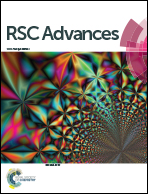Effects of the aspect ratio of the conductive agent on the kinetic properties of lithium ion batteries†
Abstract
We fabricated lithium-ion batteries (LIBs) using the Super P and carbon nanotubes (CNTs) as conductive agents to investigate the effect of the aspect ratio of conductive agent on the kinetic properties of LIB. The electrode fabricated with CNTs, which have a high aspect ratio (length: 200 μm), exhibited outstanding rate capability at 30C despite of their low concentration, while the electrode fabricated with the carbon black showed poor rate capability. These results indicate that the aspect ratio of conductive agent influence the diffusion coefficient of lithium ions, which is calculated from the galvanostatic intermittent titration technique analysis, and that conductive agent should have high aspect ratio to improve the kinetic properties of LIBs. This study provides insights that are useful for designing high-performance LIBs by reducing the amount of conductive agent, leading to increased loading of active material.



 Please wait while we load your content...
Please wait while we load your content...